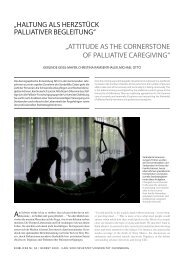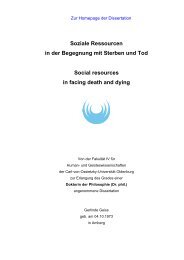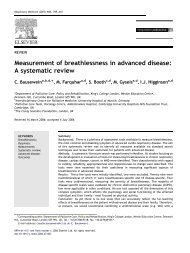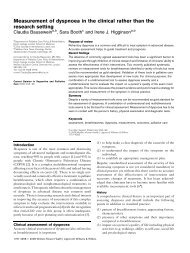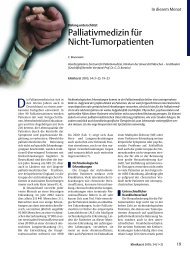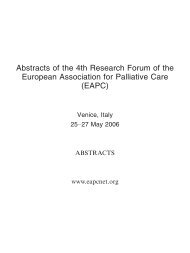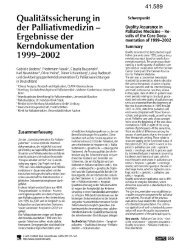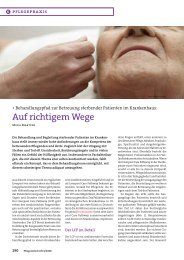EAPC - ipac
EAPC - ipac
EAPC - ipac
Create successful ePaper yourself
Turn your PDF publications into a flip-book with our unique Google optimized e-Paper software.
442 <strong>EAPC</strong> Abstracts<br />
142 Oral Presentation<br />
Assessment and measurement of quality of life and other<br />
symptoms<br />
Developing a Measure of Quality of Death and Dying (QODD) in<br />
the Pediatric Intensive Care Unit (PICU)<br />
Authors: Mildred Solomon Center for Applied Ethics Education<br />
Development Center U. STATES<br />
Adena Cohen-Bearak Education Development Center Newton U. STATES<br />
Deborah Sellers Education Development Center Newton U. STATES<br />
Sarah McGraw New England Research Institutes Watertown U. STATES<br />
Robert Truog Education Development Center Newton U. STATES<br />
Background: End-of-life care in the PICU poses challenges distinct from<br />
those for adults. Relatively little information is available about the quality<br />
of dying and death in the PICU. We present the results from a qualitative<br />
study to develop a measure of QODD in the PICU. Our aims are to<br />
describe constructs and indicators through: 1) a systematic literature<br />
review and 2) focus groups with PICU providers. These findings, combined<br />
with interviews with bereaved family members, will inform the<br />
development of a PICU QODD instrument. Methods: A Medline search<br />
identified 99 relevant articles. A moderator conducted six focus groups<br />
about death and dying in the PICU with 65 PICU providers (physicians,<br />
nurses and psychosocial) from two teaching hospitals. The study team<br />
abstracted themes and specific indicators on decision-making, family and<br />
clinician concerns, and quality of care from the 99 articles. Using both<br />
inductive and deductive approaches, three coders first read the transcripts<br />
and coded for the domains identified in the literature and new domains<br />
emerging from the transcripts. Second, they identified sub-themes and topics<br />
within each domain. Results: Eight core domains with indicators were<br />
identified: 1) Decisions; 2) Conflict; 3) Communication; 4) Continuity of<br />
care; 5) Emotional and psychosocial needs of the family; 6) Pain and other<br />
symptoms; 7) Choices around the circumstances of death and;<br />
8) Bereavement. A meta-theme, underlying all of the focus group findings,<br />
was the notion of the uniqueness of each child, family, and the circumstances<br />
of death. Conclusions: Some domains and indicators are unique to<br />
the PICU; unlike for adults, autonomy is not a core domain.<br />
Accommodating the uniqueness of each circumstance presents methodological<br />
challenges for the development of a tool. Measures should address<br />
the subjective assessment of satisfaction with care and alignment with<br />
hopes and priorities.<br />
143 Oral Presentation<br />
Assessment and measurement of quality of life and other<br />
symptoms<br />
Evaluation of the Palliative Prognostic Score (PaP) and routinely<br />
collected clinical data in prognostication of survival for<br />
patients referred to a palliative care consultation service in an<br />
acute care hospital<br />
Authors: Yoko Tarumi Oncology/Palliative Care Medicine University of<br />
Alberta CANADA<br />
Francis Lau University of Victoria, Health Information Science Victoria<br />
CANADA<br />
Lorelei Sawchuk Royal Alexandra Hospital, Palliative Care Program<br />
Edmonton CANADA<br />
Hue Quan Capital Health Regional Palliative Care Program Edmonton<br />
CANADA<br />
Sharon Watanabe University of Alberta, Onclogy/Palliative Care Medicine<br />
Edmonton CANADA<br />
Background: The PaP is a validated tool for survival prognostication in palliative<br />
care patients. The purpose of this study is to further validate the PaP<br />
and examine the additional prognostic utility of routinely collected clinical<br />
data. Methods: Cancer and non-cancer patients referred to a palliative care<br />
consultation service at an acute care hospital were included. This was a<br />
prospective cohort study on survival prediction based on PaP and other routinely<br />
collected clinical data: Palliative Performance (PPS), Folstein Mini<br />
Mental State Examination Score (MMSE), Edmonton Symptom<br />
Assessment Scale. Data were collected at initial consultation, and again at<br />
the time of final decision making for discharge planning. Other predictor<br />
variables were obtained via routinely collected administrative data including<br />
age group, gender, primary diagnosis, problems at referral, location and<br />
date of discharge, and location and date of death. Statistical Analysis:<br />
1) Kaplan-Meier (KM) survival analysis for above listed variables;<br />
2) Hazard ratios for death with above variables; 3) Calculation of PaP using<br />
both PPS and KPS; 4) Survival rate (%) by above variables. Results: A total<br />
312 cases have been included in the preliminary data analysis. 95 cases<br />
have been censored due to unavailability of date of death (expected to be<br />
ready by the end of 2007). KM analysis for PaP showed 30 day survival<br />
rates that are consistent with previous studies in each risk category: A<br />
(>70%), B (30–70%), and C (



